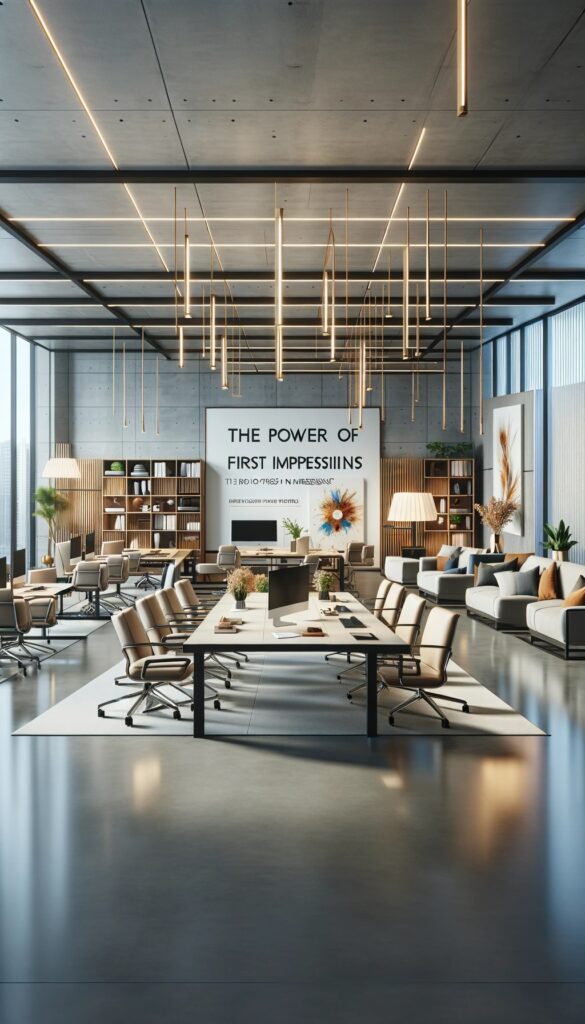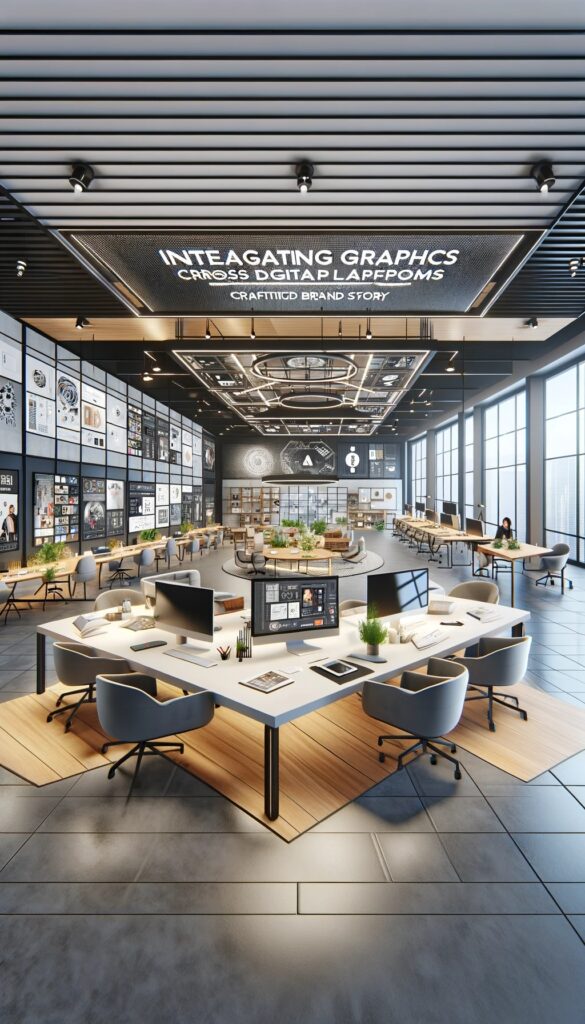Table of Contents
Introduction: The Vital Role of Graphic Design in Digital Marketing
In the digital era, where every scroll, click, and view is a potential opportunity, the importance of graphic design in digital marketing becomes not just relevant but absolutely crucial. As you seek to enhance your online presence, it’s essential to recognize how graphic design acts as the silent ambassador of your brand, speaking volumes before a single word is read.
Imagine your brand as a canvas, and graphic design as the palette of colors you use to paint your brand’s story. This is where art meets commerce, where creativity aligns with strategy. In the digital marketplace, your audience is greeted first by visuals, be they on your website, social media, or advertisements. These visuals are the first handshake, the first impression, and the opening dialogue between your brand and your potential customers.
The role of graphic design in digital marketing is multifaceted. It’s not just about making things look pretty; it’s about creating a visual language that communicates your brand’s values, ethos, and personality. Effective graphic design translates complex ideas into clear, visually engaging messages. It helps to convey your message in an instant, breaking through the noise and clutter of the digital world to capture the fleeting attention of your audience.
But why is this so important? In the digital age, consumers are bombarded with information, making it increasingly challenging to stand out. Good graphic design can be the difference between being noticed or overlooked. It’s about making a memorable impact, ensuring your brand stays etched in the minds of your audience long after they’ve scrolled past.
As we delve deeper into the nuances of graphic design in the following chapters, remember that each element of design—from color to typography, imagery to layout – plays a crucial role in crafting your online identity. It’s these elements that will help you connect with your audience, tell your story, and ultimately achieve your digital marketing goals.
The Power of First Impressions: The Role of Visual Impact in Marketing
In the realm of digital marketing, the power of first impressions cannot be overstated. Visual impact in marketing is the silent yet potent force that can make or break a customer’s perception of your brand in mere seconds. Imagine the moment a potential customer encounters your brand online. Before they read a word of text, it’s the visual design that speaks to them, setting the tone for their entire experience with your brand.
Effective graphic design acts like a magnet, instantly drawing the viewer’s eye and engaging their interest. It’s the difference between a potential customer pausing to explore your content or continuing to scroll past. In this digital age, where attention spans are shorter than ever, the ability to capture and hold this attention is invaluable.
Consider the impact of a well-designed website, a striking logo, or an eye-catching social media post. These are not just aesthetic elements; they are powerful tools that convey your brand’s message, values, and personality. Good design creates a sense of professionalism and trustworthiness, encouraging viewers to explore further.
But why is this initial visual impact so crucial? In the digital marketplace, you often only get one chance to make a good impression. A visually appealing design can create a memorable experience, ensuring that your brand stands out in a crowded online space. It’s about creating a connection at first glance, a visual handshake that invites the viewer to learn more.
As you continue to explore the importance of visual impact in marketing, remember that every element of your design is an opportunity to tell your brand’s story and engage your audience. It’s these first impressions that lay the foundation for lasting relationships with your customers.

Aligning Design with Brand Identity: Crafting a Consistent Image
In the journey of building a brand, aligning graphic design with your brand identity is a pivotal step towards ensuring recognition and consistency. Imagine, as your brand grows, how a consistent design becomes synonymous with your brand’s identity, making it instantly recognizable in the sea of digital content. This is the power of brand identity design, a strategic art that blends visuals with the essence of your brand.
The alignment of design with brand identity is like creating a visual language that speaks directly to your audience. It’s about using colors, typography, imagery, and style to tell your brand’s story. When these elements are in harmony, they create a strong, cohesive brand image that resonates with your audience and reinforces your brand’s message.
But why is this alignment so crucial? Consistency in design builds familiarity, and familiarity breeds trust. When your audience sees a consistent visual theme across all your platforms, it creates a sense of reliability and professionalism. This consistency helps cement your brand’s identity in the minds of your audience, making your brand more memorable and recognizable.
Envision your brand’s future: a future where your audience can identify your content with just a glance, where your brand’s visual identity becomes an asset in itself. This future is achievable through thoughtful and consistent brand identity design.
To learn more about aligning your graphic design with your brand identity and to explore strategies for creating a cohesive brand image, delve into our comprehensive guide.
As you continue on your brand-building journey, remember that every design choice you make is an opportunity to reinforce your brand’s identity. It’s these choices that will shape how your audience perceives and remembers your brand, paving the way for growth and recognition in the digital world.
The Psychology of Colors and Fonts in Design: Shaping Perceptions and Behaviors
In the tapestry of digital marketing, colors and fonts are not mere embellishments; they are the threads that weave the personality of your brand. The use of color psychology in marketing is akin to a chef using spices; a little can enhance the flavor, and too much can overpower it. Similarly, fonts are the tone of voice in your visual conversation with the audience. Together, they influence customer perception and behavior in subtle yet profound ways.
Imagine colors as the emotional cues in your marketing narrative. Each color evokes a different feeling: blue instills trust and security, red evokes excitement and urgency, and green communicates growth and harmony. Like an artist choosing a palette, selecting the right colors for your brand can create an emotional connection with your audience, influencing how they perceive your brand’s personality.
Fonts, on the other hand, are the vocal tones of your brand’s story. A serif font, like a deep, resonant voice, may convey tradition and reliability. A sans-serif font, clear and straightforward, can communicate modernity and approachability. The right font choice ensures that your message is not just seen but also felt in the way you intend.
But why is understanding this psychology so crucial? In a digital world where consumers are constantly bombarded with information, the right combination of colors and fonts can make your message stand out, resonate, and be remembered. It’s about creating a visual experience that aligns with your brand’s message and values, leading to deeper engagement and a stronger emotional response from your audience.

As you continue to craft your brand’s digital narrative, remember that colors and fonts are powerful tools in shaping how your audience perceives and interacts with your brand. They are the silent yet impactful characters in your brand’s story, each playing a crucial role in creating a lasting impression.
Balancing Aesthetics and Functionality: The Key to User-Friendly Design
In the world of digital marketing, the balance between aesthetics and functionality in graphic design is akin to a tightrope walker maintaining their poise; it’s a delicate yet crucial act. This balance is the essence of user-friendly design, where beauty meets utility and form harmonizes with function. Imagine a design that catches the eye but also leads the user effortlessly towards the desired action – this is the sweet spot of effective graphic design.
On one side of the spectrum, there are designs that are visually stunning but overly complex, leading to confusion and a poor user experience. On the other hand, there are designs that are overly simplistic, efficient, and yet uninspiring. The art lies in striking the right balance – creating designs that are not only aesthetically pleasing but also intuitive and easy to navigate.
Why is this balance so important? In the digital space, a user’s experience with your design can make or break their relationship with your brand. A well-balanced design speaks of a brand that values both form and function, showing a deep understanding of the user’s needs. It’s about creating an experience that is visually engaging and emotionally resonant, yet straightforward and user-friendly.
Consider your own experiences as a user. The most memorable and positive experiences are often with designs that blend beauty with usability seamlessly. These are the designs that invite exploration, create engagement, and leave a lasting impression.
To learn more about achieving this crucial balance in your graphic design and to enhance your brand’s user experience, explore our comprehensive guide.
As you continue to refine your brand’s digital presence, remember that every design choice should contribute to a harmonious balance between aesthetics and functionality. It’s this balance that will captivate your audience, enhance their experience, and ultimately foster a deeper connection with your brand.
Keeping Up with Design Trends: Staying Relevant and Engaging
In the ever-evolving world of digital marketing, keeping up with the latest graphic design trends is not just a choice but a necessity for maintaining relevance and engagement. As you navigate through the dynamic landscape of design, it’s understood that adopting new trends is key to keeping your brand fresh and captivating. Imagine your brand as a living entity, constantly evolving and adapting to the changing environment to stay vibrant and relevant.
Current trends in graphic design are like the pulse of the market, indicating the direction in which consumer preferences are moving. From minimalist designs that speak volumes with less to bold typography that captures attention, each trend offers a unique way to communicate your brand’s message. The use of vibrant colors, innovative layouts, and interactive elements is not just about being trendy; it’s about connecting with your audience in ways that resonate with their current tastes and preferences.
Why is it important to stay updated with these trends? In a digital space crowded with content, staying on top of design trends helps your brand stand out. It shows that your brand is forward-thinking, adaptable, and in tune with the audience’s evolving aesthetic sensibilities. More importantly, it demonstrates a commitment to delivering an experience that is not just current but also enjoyable and relevant to your audience.

As you continue to refine your brand’s visual identity, remember that keeping up with design trends is about more than just aesthetics. It’s about understanding your audience, anticipating their preferences, and crafting a visual language that speaks directly to their current experiences and desires. By staying updated on these trends, you’re not just updating your design; you’re renewing your brand’s connection with your audience.
Integrating Graphics Across Digital Platforms: Crafting a Unified Brand Story
In the digital age, where your brand’s story unfolds across multiple platforms, the art of cross-platform graphic design becomes crucial in creating a cohesive narrative. Imagine your brand as a character in a story, traversing different worlds – from the land of social media to the realms of websites and email campaigns. In each space, your brand’s visual identity needs to be consistent yet adaptable, creating a seamless experience for your audience.

Effective integration of graphic design across digital platforms is akin to a well-orchestrated symphony. Each platform is an instrument, playing its own unique part, but together, they create a harmonious melody that resonates with your audience. The key is to maintain a consistent core design – a recognizable color scheme, typography, and imagery – that adapts fluidly to the nuances of each platform.
Why is this integration so important? In a world where consumers interact with brands across various digital touchpoints, a unified graphic design approach ensures that your brand is easily recognizable and memorable. It builds a sense of trust and familiarity, which is essential in nurturing a long-term relationship with your audience.
Consider the journey of your brand across these platforms. On social media, your graphics need to be eye-catching and shareable. On your website, they should enhance the user experience, guiding visitors intuitively through your content. In emails, your design should be engaging yet unobtrusive, enhancing your message without overwhelming it.
As you continue to weave your brand’s story across various digital platforms, remember that each graphic element is a chapter in your brand’s narrative. By ensuring consistency and adaptability in your design, you’re not just creating a visual identity; you’re building a story that your audience wants to be a part of.
Measuring the Impact of Your Design: The Art of Design Effectiveness Analysis
In the intricate dance of digital marketing, measuring the impact of your graphic design is not just a step but a leap towards understanding and enhancing your marketing outcomes. The process of design effectiveness analysis is akin to a mirror, reflecting the success of your visual strategies and guiding you towards more informed decisions. Imagine each element of your design as a cog in a larger machine, each contributing to the overall effectiveness of your marketing campaign.
Understanding the cause-and-effect relationship between effective design and marketing success is crucial. A well-crafted design can lead to higher engagement, increased brand recognition, and ultimately, better conversion rates. But how do you measure this impact? It’s not just about aesthetics; it’s about functionality and the ability to achieve your marketing objectives.
Methods to measure the impact of graphic design in digital marketing campaigns are diverse and data-driven. Key performance indicators (KPIs), such as click-through rates, engagement rates, conversion rates, and time spent on your website, can offer insights into how your audience is interacting with your designs. A/B testing different design elements can reveal what resonates best with your audience, allowing you to refine your approach for maximum impact.
Social media analytics can also provide valuable feedback on how your designs are performing in terms of likes, shares, and comments. These metrics can help you gauge the emotional impact and shareability of your designs, which are crucial to the viral nature of digital content.
To delve deeper into how to measure and analyze the effectiveness of your graphic design and to learn strategies for optimizing your visual content, explore our comprehensive guide.
As you continue to navigate the world of digital marketing, remember that the impact of your design is not just seen but also felt. It’s in the way your audience interacts with your brand, the impressions they form, and the decisions they make. By measuring and analyzing the effectiveness of your design, you’re not just creating visuals; you’re crafting experiences that drive results.
Conclusion: Leveraging Graphic Design for Online Success
As we reach the conclusion of our exploration into the world of graphic design, it’s clear that the power of visual elements in enhancing your online presence is undeniable. Leveraging graphic design for online success is not just about creating visually appealing content; it’s about crafting a visual language that communicates, engages, and resonates with your audience. Each aspect we’ve discussed – from the psychology of colors and fonts to the integration of designs across platforms – plays a pivotal role in shaping your brand’s digital narrative.
Reflect on the journey we’ve taken together, from understanding the impact of first impressions to measuring the effectiveness of your designs. It’s evident that graphic design is a crucial tool in your digital marketing arsenal, one that has the power to transform your brand’s online presence. The integration of aesthetics and functionality, keeping up with design trends, and ensuring consistency across platforms are not just strategies; they are essential practices that can elevate your brand to new heights.
Now, as you stand at the crossroads of creativity and strategy, it’s time to apply these insights. Imagine the potential of your brand as you implement these tips, envisioning a future where your designs not only capture attention but also drive engagement and conversions. The path to online success is paved with the choices you make in your graphic design approach.
Remember, the world of digital marketing is ever-evolving, and staying ahead requires not just following trends but also understanding the fundamental principles of effective design. Your journey in leveraging graphic design for online success is ongoing, and each step you take is an opportunity to refine, enhance, and innovate.
As you move forward, keep these insights close and let them guide your design decisions. Embrace the power of graphic design and watch as it transforms your online presence, leading to greater engagement, stronger brand recognition, and ultimately, better digital marketing outcomes.

